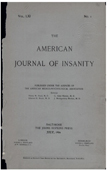Abstract
We may summarize the pathological changes found in status epilepticus and in epilepsy in general, as follows:
The first discoverable lesion appears in the nucleus, and this is the organ of the cell first and most seriously involved. The nuclear membrane and the karyoplasmic network disappear and the karyoplasm becomes finely granular, the direct result of the destruction of the karyoplasmic network. In consequence, the anchorage of the nucleolus is destroyed, and it becomes a free body within the nucleus. In the process of making the section many of these free nucleoli are abstracted from the nuclei to which they belong and appear in the section entirely outside of the cell—nucleolar abstraction (Figs. I, 3, 4 and 5; Photomicrographs 1 and 2). Many nucleoli are greatly displaced within the nucleus (Fig. 2).
The following secondary changes take place in the order named:
The granules of the chromatic substance disappear from the cell body, leaving behind a dimly outlined cell framework. All trace of the nucleus finally disappears and nothing remains of the nerve cell but a shapeless mass of vacuolated protoplasm. Many neurons disappear from the cortex, especially from the second and third layers (Figs. 7, 9 and 10).
The cortex becomes invaded by leucocytes, the chief mission of which is probably the removal of the debris of destroyed nerve cells and poisonous products. The variety of leucocyte found in the vast majority of instances is a cell with marked phagocytic properties, the large mononuclear (Figs. 9 and 10).
The neuroglia proliferates to take the place of the destroyed nerve cells. This proliferation is most marked in the outer cortical layer and is largely proportional to the duration and severity of the epilepsy. The destructive process especially involves nerve cells in the second layer, and the third layer in lesser degree.
The significance of these changes is rather important. Speaking broadly, the epileptic fit is a destructive process. We can hardly have observed the gradually increasing dementia of the epileptic without having thus concluded, regardless of the pathological findings; however, the pathological changes found in the cerebral cortex, together with the life history of the epileptic, confirm this fact definitely. The especial involvement of the nucleus of certain of the cells of the cortex is a fact of great importance. Biological facts teach us that "the formative power of the cell centres in the nucleus, and it is therefore to be regarded as the especial organ of inheritance;" that "it plays an essential rôle in chemical synthesis;" that "digestion and absorption of food, growth and secretion cease with its removal from the cytoplasm;" and that "fragments of protoplasm deprived of the nucleus die." (Wilson, Verworn). When, therefore, morbid processes especially attack the nucleus, the portion of the cell essential to its life becomes jeopardized. From the foregoing, we are justified in assuming, not only that the essential poison in epilepsy is a nuclear poison that shows a special predilection for certain delicately constituted cells of the cerebral cortex, but that the chromatolysis which appears as a widespread condition, particularly in all cases of status, is a nutritional change, brought about chiefly by the jeopardization of the nucleus, which is known to preside over the nutritional functions within the cell. This assumes that "the chromatic bodies constitute surplus nutritive products of the nerve cell or represent potential energy in the nerve cell." Ewing's review of the literature bearing upon this point, and his own personal study of this subject would seem to warrant the conclusion quoted.
We have previously mentioned the probable phagocytic mission of the leucocytes that are found to have invaded the cortex. This is a fact of great significance. Phagocytosis occurs as one of the sequences of the action of toxic elements upon certain cells. In our cases of epilepsy we have to look upon the leucocytes found in the cortex as phagocytes.
The question as to whether or not the neuroglia cells ever become phagocytic is suggested in the recent work of Mallory. He has shown that many cells of endothelial type and origin become markedly phagocytic in response to the action of certain toxic substances. Various authors, many of whom were noted at the outset of this study, have described the neuroglia proliferation in epilepsy. We have found it in greater or lesser degree in all the cases examined, and believe that, with improved methods and technique, it will be demonstrated in every case of epilepsy of any considerable duration. Inasmuch as cells proliferate in response to the action of toxic or irritating substances, it seems right to look upon the neuroglia proliferation in epilepsy as evidence of the underlying toxic character of the disease.
There is a secondary reason for the neuroglia proliferation in epilepsy. The nerve cell once destroyed is never replaced. The vacancy caused by its disappearance must be taken by cells capable of proliferation. The great increase in the neuroglia in epilepsy occurs therefore in response to (a) the action of toxic elements upon the neuroglia cell, and (b) as a direct sequence of nerve cell destruction.

